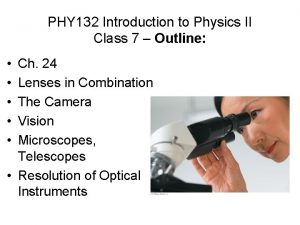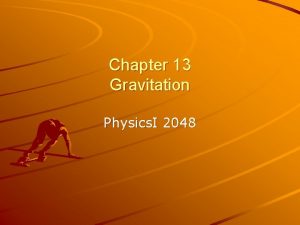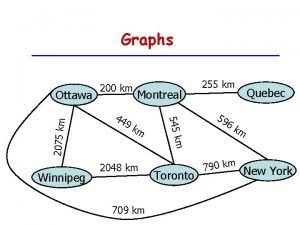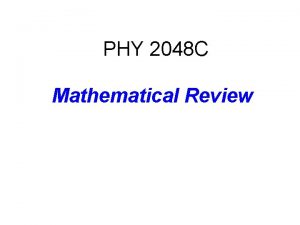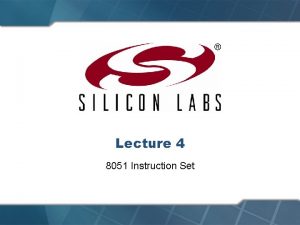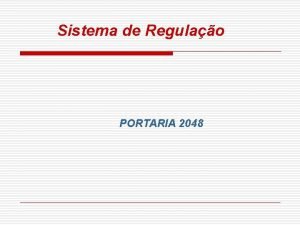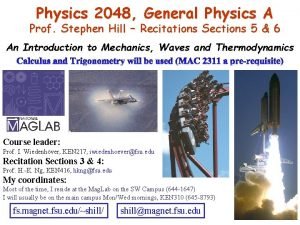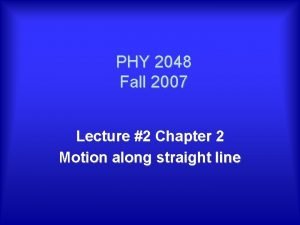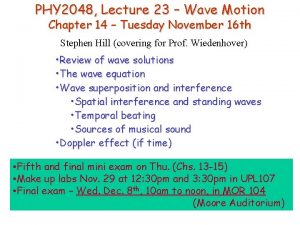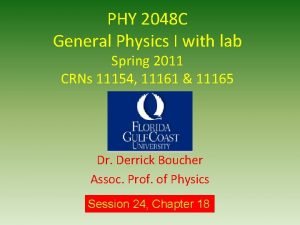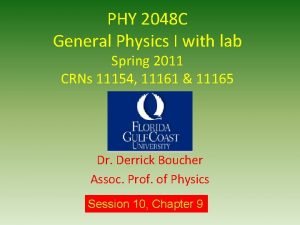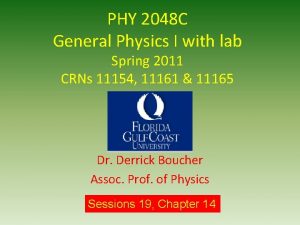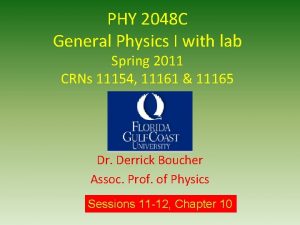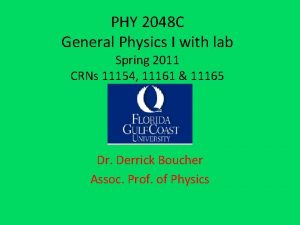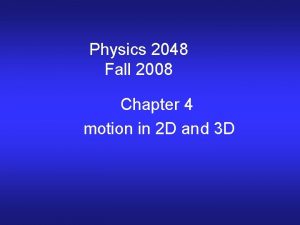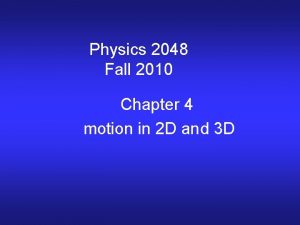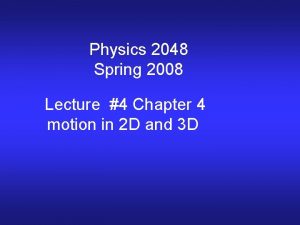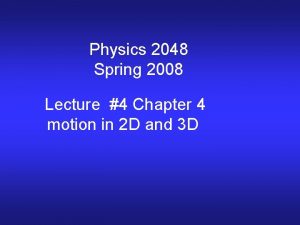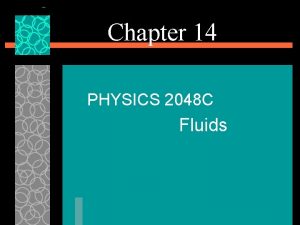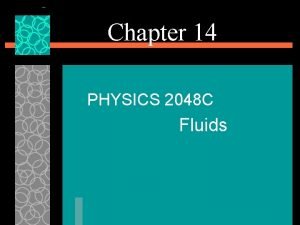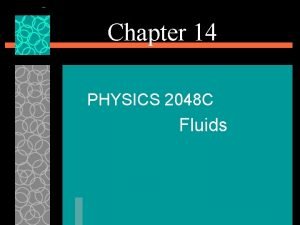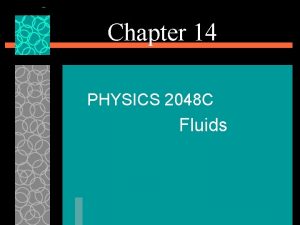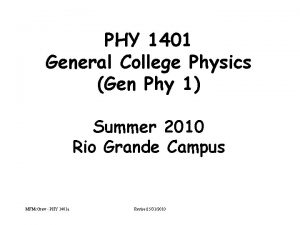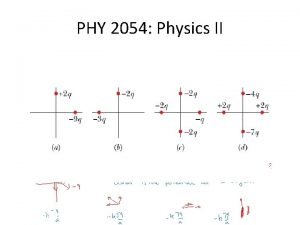PHY 2048 Fall 2007 Lecture 2 Chapter 2
























- Slides: 24

PHY 2048 Fall 2007 Lecture #2 Chapter 2 Motion along straight line

Chapter 1 - Introduction I. International System of Units II. Conversion of units III. Dimensional Analysis

I. International System of Units QUANTITY UNIT NAME UNIT SYMBOL POWER PREFIX ABBREVIATION 1015 peta P 1012 tera T 109 giga G 106 mega M Length meter m Time second s Mass kilogram kg 103 kilo k Speed m/s 102 hecto h Acceleration m/s 2 101 deka da 10 -1 deci D 10 -2 centi c 10 -3 milli m 10 -6 micro μ 10 -9 nano n 10 -12 pico p 10 -15 femto f Force Newton N=kgm/s 2 Pressure Pascal Pa = N/m 2 Joule Nm=kgm 2/s 2 Energy J= Power Watt W = J/s Temperature Kelvin K

II. Conversion of units Chain-link conversion method: The original data are multiplied successively by conversion factors written as unity. The units are manipulated like algebraic quantities until only the desired units remain. Example: 316 feet/h m/s III. Dimensional Analysis Dimension of a quantity: indicates the type of quantity it is; length [L], mass [M], time [T] Dimensional consistency: an equation is dimensionally consistent if each term in it has the same dimensions. Example: x=x 0+v 0 t+at 2/2

Problem solving tactics • Explain the problem with your own words. • Make a good picture describing the problem. • Write down the given data with their units. Convert all data into S. I. system. • Identify the unknowns. • Find the connections between the unknowns and the data. • Write the physical equations that can be applied to the problem. • Solve those equations. • Check if the values obtained are reasonable order of magnitude and units.

MECHANICS Kinematics Chapter 2 - Motion along a straight line I. Position and displacement II. Velocity III. Acceleration IV. Motion in one dimension with constant acceleration V. Free fall

I. Position and displacement Change from position x 1 to x 2 Displacement: Δx = x 2 -x 1 (2. 1) - Vector quantity: Magnitude (absolute value) and direction (sign). - Coordinate ≠ Distance x ≠ Δx x x Coordinate system x 1=x 2 x 1 t Δx >0 t Δx = 0 Only the initial and final coordinates influence the displacement many different motions between x 1 and x 2 give the same displacement.

Distance: total length of travel. - Scalar quantity Displacement ≠ Distance Example: round trip house-work-house distance traveled = 10 km displacement = 0 II. Velocity Average velocity: Ratio of the displacement Δx that occurs during a particular time interval Δt to that interval. Motion along x-axis - Vector quantity indicates not just how fast an object is moving but also in which direction it is moving. - The slope of a straight line connecting 2 points on an x-versus-t plot is equal to the average velocity during that time interval.

Average speed: Total distance covered in a time interval. Savg ≠ magnitude Vavg Scalar quantity Savg always >0 Example: A person drives 4 mi at 30 mi/h and 4 mi and 50 mi/h Is the average speed >, <, = 40 mi/h ? <40 mi/h t 1= 4 mi/(30 mi/h)=0. 13 h ; t 2= 4 mi/(50 mi/h)=0. 08 h ttot= 0. 213 h Savg= 8 mi/0. 213 h = 37. 5 mi/h Instantaneous velocity: How fast a particle is moving at a given instant. - Vector quantity

Instantaneous velocity: Position Slope of the particle’s position-time curve at a given instant of time. V is tangent to x(t) when Δt 0 When the velocity is constant, the average velocity over any time interval is equal to the instantaneous velocity at any time. Instantaneous speed: Magnitude of the instantaneous velocity. Example: car speedometer. - Scalar quantity Average velocity (or average acceleration) always refers to an specific time interval. Instantaneous velocity (acceleration) refers to an specific instant of time. Time

III. Acceleration Average acceleration: Ratio of a change in velocity Δv to the time interval Δt in which the change occurs. - Vector quantity V - The average acceleration in a “v-t” plot is the slope of a straight line connecting points corresponding to two different times. Instantaneous acceleration: Rate of change of velocity with time. - Vector quantity - The instantaneous acceleration is the slope of the tangent line (v-t plot) at a particular time. t t t

If particle’s velocity and acceleration have same sign particle’s speed increases. If the signs are opposite speed decreases. Positive acceleration does not necessarily imply speeding up, and negative acceleration slowing down. Example: v 1= -25 m/s ; v 2= 0 m/s in 5 s particle slows down, aavg= 5 m/s 2 An object can have simultaneously v=0 and a≠ 0 Example: x(t)=At 2 v(t)=2 At a(t)=2 A ; At t=0 s, v(0)=0 but a(0)=2 A IV. Motion in one dimension with constant acceleration - Average acceleration and instantaneous acceleration are equal.

1 D motion with constant acceleration tf – ti = t

1 D motion with constant acceleration Using (1) and than substituting into equation for final position yields (2) Equations (1) and (2) are the basic kinematics equations

1 D motion with constant acceleration • In a similar manner we can rewrite equation for average velocity: • and than solve it for xf • Rearranging, and assuming

1 D motion with constant acceleration These two equations can be combined to yield additional equations. We can eliminate t to obtain Second, we can eliminate the acceleration a to produce an equation in which acceleration does not appear:

Equations of motion

Equations of motion

Kinematics with constant acceleration Summary

Kinematics - Example 1 • How long does it take for a train to come to rest if it decelerates at 2. 0 m/s 2 from an initial velocity of 60 km/h? – Using we rearrange to solve for t: – Vf = 0. 0 km/h, vi=60 km/h and a= -2. 0 m/s 2. – Substituting we have

- Equations for motion with constant acceleration: t t missing t t

- The motion equations can also be obtained by indefinite integration: V. Free fall Motion direction along y-axis ( y >0 upwards) Free fall acceleration: (near Earth’s surface) a= -g = -9. 8 m/s 2 (in cte acceleration mov. eqs. ) Due to gravity downward on y, directed toward Earth’s center

Approximations: - Locally, Earth’s surface essentially flat free fall “a” has same direction at slightly different points. - All objects at the same place have same free fall “a” (neglecting air influence). VI. Graphical integration in motion analysis From a(t) versus t graph integration = area between acceleration curve and time axis, from t 0 to t 1 v(t) Similarly, from v(t) versus t graph integration = area under curve from t 0 to t 1 x(t)

B 1: A rocket is launched vertically from the ground with an initial velocity of 80 m/s. It ascends with a constant acceleration of 4 m/s 2 to an altitude of 10 km. Its motors then fail, and the rocket continues upward as a free fall particle and then falls back down. (a) What is the total time elapsed from takeoff until the rocket strikes the ground? (b) What is the maximum altitude reached? 1) Ascent a 0= 4 m/s 2 (c) What is the velocity just before hitting ground? y y 2=ymax v 2=0, t 2 a 1= -g t 2 t 3=t 2 2) Ascent a= -9. 8 m/s 2 +v 1, t 1 y 1= 10 km a 0= 4 m/s 2 t 1 t 4 v 0= 80 m/s a 2= -g Total time ascent = t 1+t 2= 53. 48 s+29. 96 s= 83. 44 s t 0=0 v 3 x 3) Descent a= -9. 8 m/s 2 ttotal=t 1+2 t 2+t 4= 53. 48 s + 2· 29. 96 s + 24. 22 s=137. 62 s hmax= y 2 -104 m = v 1 t 2 -4. 9 t 22= (294 m/s)(29. 96 s)- (4. 9 m/s 2)(29. 96 s)2 = 4410 m
 Phy 132 lecture 10: ch30
Phy 132 lecture 10: ch30 Let me go mr hill chapter 2048
Let me go mr hill chapter 2048 01:640:244 lecture notes - lecture 15: plat, idah, farad
01:640:244 lecture notes - lecture 15: plat, idah, farad 10ud 2048
10ud 2048 Expectimax pseudocode
Expectimax pseudocode Js 2048
Js 2048 X 2048
X 2048 2048 x 1556 aspect ratio
2048 x 1556 aspect ratio 2048.c
2048.c Portaria 2048/2009
Portaria 2048/2009 Sailor rt2048 handset
Sailor rt2048 handset The instruction xch a @ri specifies
The instruction xch a @ri specifies Portaria 2048 de 2009
Portaria 2048 de 2009 Phy 2048c fsu
Phy 2048c fsu Phy 131 past papers
Phy 131 past papers Phy 231 msu
Phy 231 msu Great orthogonality theorem in group theory
Great orthogonality theorem in group theory Phy 221 msu
Phy 221 msu Phy theorem
Phy theorem Phy113
Phy113 Phy 131 asu
Phy 131 asu Ddr phy architecture
Ddr phy architecture Phy 205
Phy 205 Accommodation eye
Accommodation eye Phy 2049
Phy 2049
